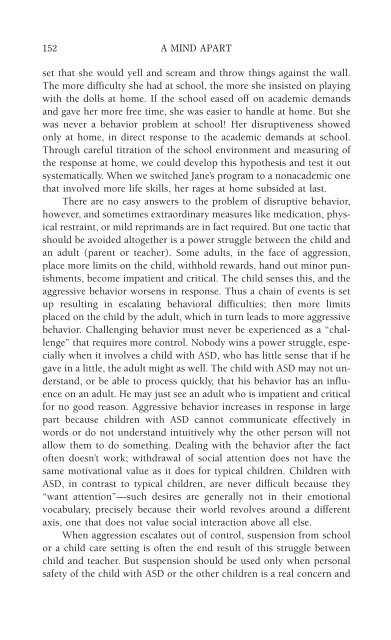978-1572305441
autism
autism
Create successful ePaper yourself
Turn your PDF publications into a flip-book with our unique Google optimized e-Paper software.
152 A MIND APART<br />
set that she would yell and scream and throw things against the wall.<br />
The more difficulty she had at school, the more she insisted on playing<br />
with the dolls at home. If the school eased off on academic demands<br />
and gave her more free time, she was easier to handle at home. But she<br />
was never a behavior problem at school! Her disruptiveness showed<br />
only at home, in direct response to the academic demands at school.<br />
Through careful titration of the school environment and measuring of<br />
the response at home, we could develop this hypothesis and test it out<br />
systematically. When we switched Jane’s program to a nonacademic one<br />
that involved more life skills, her rages at home subsided at last.<br />
There are no easy answers to the problem of disruptive behavior,<br />
however, and sometimes extraordinary measures like medication, physical<br />
restraint, or mild reprimands are in fact required. But one tactic that<br />
should be avoided altogether is a power struggle between the child and<br />
an adult (parent or teacher). Some adults, in the face of aggression,<br />
place more limits on the child, withhold rewards, hand out minor punishments,<br />
become impatient and critical. The child senses this, and the<br />
aggressive behavior worsens in response. Thus a chain of events is set<br />
up resulting in escalating behavioral difficulties; then more limits<br />
placed on the child by the adult, which in turn leads to more aggressive<br />
behavior. Challenging behavior must never be experienced as a “challenge”<br />
that requires more control. Nobody wins a power struggle, especially<br />
when it involves a child with ASD, who has little sense that if he<br />
gave in a little, the adult might as well. The child with ASD may not understand,<br />
or be able to process quickly, that his behavior has an influence<br />
on an adult. He may just see an adult who is impatient and critical<br />
for no good reason. Aggressive behavior increases in response in large<br />
part because children with ASD cannot communicate effectively in<br />
words or do not understand intuitively why the other person will not<br />
allow them to do something. Dealing with the behavior after the fact<br />
often doesn’t work; withdrawal of social attention does not have the<br />
same motivational value as it does for typical children. Children with<br />
ASD, in contrast to typical children, are never difficult because they<br />
“want attention”—such desires are generally not in their emotional<br />
vocabulary, precisely because their world revolves around a different<br />
axis, one that does not value social interaction above all else.<br />
When aggression escalates out of control, suspension from school<br />
or a child care setting is often the end result of this struggle between<br />
child and teacher. But suspension should be used only when personal<br />
safety of the child with ASD or the other children is a real concern and



